Another Timbre TimHarrisonbre
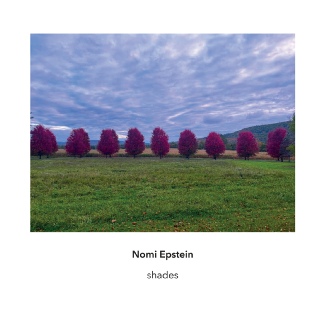
at222 Nomi Epstein ‘shades’
1 shades (2023) 20:31
Apartment House: Mira Benjamin & Amalia Young, violins
Bridget Carey, viola Anton Lukoszevieze, cello
2 sounds for Berlin (2019) 20:25
Christian Kesten, voice & whistle Michiko Ogawa, clarinet
Miako Klein, violin Joseph Houston, piano & whistle
3 Sextet (2011) 26:10
Apartent House: Amalia Young, violin Bridget Carey, viola Anton Lukoszevieze, cello
Heather Roche, clarinet Nancy Ruffer, flute Ben Smith, piano
Interview with Nomi Epstein
Can you tell us about your background, and how you came to experimental music?
As a child, new music was a regular part of the sound world of my house, since my father’s new music ensemble rehearsed in our basement. Early on in my studies I was drawn to the New York School composers. Over the years, at festivals like Ostrava Days, I worked with a lot of composers who fostered the notational, indeterminate, and aesthetic inquiries I was interested in. When I arrived at Northwestern for my grad program, I’d heard that I had just missed studying with a few experimental music faculty who’d recently left, and my classmates and I found a shared interest in these kinds of works, ideas, types of listening. In the years after my grad program, I started performing, discussing, curating, and working with a lot of these text scores, some Fluxus, some Oliveros Sonic Meditations, and some Wandelweiser scores. In 2010, I founded the a•pe•ri•od•ic ensemble, initially with the intention of focusing the programming on Wandelweiser works. But as it continued it broadened out and became more about a commitment to a particular listening and ensemble performance practice that I was enamoured with, and that really feeds my soul. Working with oblique text scores of varying levels of indeterminacy allowed me to find these egalitarian performance realisation spaces devoted to a sense of spaciousness, appreciation for subtleties of sound/silence/colour, and the group’s creation of these shared moments of sonic fragility.
I know that you teach as well as perform. Do you feel that that assists your work as a composer, or does it sometimes get in the way?
At the moment in my current professorship, teaching doesn’t quite communicate with my artistic practice, but in past positions there has certainly been more connection or relationship between these parts of my work. Over the last few years, I’ve been able to channel and focus my Deep Listening work into becoming a certified practitioner and this sort of “teaching” (leading workshops) - although we use the term “facilitating” - fosters a more reciprocal relationship with my artistic practice, so it’s been very meaningful for me.
Tell us about the Berlin 'sounds' piece on the CD. How did that come about?
Back in 2019, I was invited by Rebecca Lane and Heather Frasch to be a guest composer
for their fantastic portrait series, Vibrant Matter in Berlin. For this, I wrote
one new work, ‘sounds for Berlin’ for the ensemble they’d put together for me (which
was such a complete joy to work with)- Christian Kesten Joseph Houston, Michiko Ogawa,
and Miako Klein, and we rehearsed daily in preparation for the KM28 concert. It was
truly wonderful to get to work with this particular group of players, thinkers, humans,
and such an anomaly to have so much concentrated rehearsal time - several hours each
day for a week. So, this was quite a special experience in that, not only was I working
with these really fine players who worked together so well and easily, but we could
get far beyond the interpretive point you can usually reach with short rehearsal
periods. The depth of entry into the work, sitting with the sounds, ideas, notation
was much more comprehensive, and having spent so much time making this piece together,
with each other, the sounds carefully emerged from a uniquely connected experience
(in concert and rehearsal). I’m very grateful to this group, and to Heather and Bec.
And what about 'Sextet', the oldest piece on the disc, who was that written for, and when was it first performed?
‘Sextet’ was written for Ensemble SurPlus, who premiered it at Schloss Solitude (Stuttgart) back in 2011. I started working on the piece while in an artist residency with David Behrman and some sound artists/composers who became regular collaborators, relationships that continue today. This was in the swampland of Florida in winter, and I began collecting these fallen acorns, examining their different colours, shapes, feel, weight, size, states of decomposition, etc. One acorn was my favourite, and I still have it in safe keeping today. I began meeting with each of the artists and asking each of them to hold and describe the acorn. I was interested in their observations and how they communicated these observations (what they were drawn to describing, in what order they discussed its features, the words they used to do so). This process somehow translated into a set of line drawings where I’d draw 3-7 short horizontal lines on top of one another quickly and slightly out of sync on the page with one another, so I’d end up with these sets of short, thick line formations. I endlessly repeated this and have pages and pages of these images. I recorded the sound of myself making them, pencil on manuscript paper, though I didn’t end up using this in the piece. However, what I took from this process of line drawing and the pages filled with images was the repetitive nature of creating an image which was always a bit different. This led to my conceiving of each image as a “super-pitch,” a note which I understood as thick due to the band of microtonal increments in its makeup, and this, in turn, became the concept behind the entire piece. Each super-pitch moves through several different images of itself. Initially ‘Sextet’ was written as a 45-60 minute piece, which has yet to be performed. The abridged 20-25 minute version that is on the CD is what’s been performed over the years.
You wrote the string quartet 'shades' specifically for this recording project. How was it working with Apartment House for the first time?
First I want to say a bit about how this project came about, as it emerged almost dreamlike in my life, and I’ll forever feel incredibly connected with it because of this. One night over the pandemic quarantine, I was, as many were, feeling particularly empty, unsure, uninspired, and worried about the future. I was feeling quite lonely musically, no concerts to attend, perform, curate, no rehearsing with my ensemble, sitting even in silence with others, and as I went to sleep that night, I came up with a project I would propose the next morning. I had decided I’d propose a portrait album with Apartment House and Another Timbre. In the middle of the night, I woke up and, as habit, checked my email, and lo and behold an email sat in my inbox from you, asking if I would be interested in putting together a portrait album with Another Timbre/Apartment House. I was in disbelief. Somehow this project had completely materialised without any doing on my part except for merely having the thought of proposing it. (I’ve been unsuccessful in repeating this sort of materialisation in my life).
‘shades’ plays around with some of the structural openness that I’d explored in a few other recent pieces like my ‘portals’ where individual performers have options of how and when to enter into/exit sections, and these entries usher the rest of the ensemble into a section requiring everyone to listen closely for it possibly beginning. This was combined with my obsessive love of glissando, especially on string instruments, as well as this pull for performers between time duration notation and working through material whose playing may contradict this time.
I’d worked with a few musicians from the ensemble over the years on different projects, but getting to work with Apartment House as ensemble was new to me, an occasion I was quite excited about. Their sensitivity and respect for sound, if that makes sense, was palpable in the recording studio. I left the ‘shades’ session completely moved, transported by their work.
More generally I’m completely indebted to all of the musicians who play on this album, the beauty they’ve brought to my ears and heart. I hold this project very close to my heart. It feels very personal, as if it holds something of great meaning in my life because of the circumstances in which it came about, and the intimate sounds that were shared.
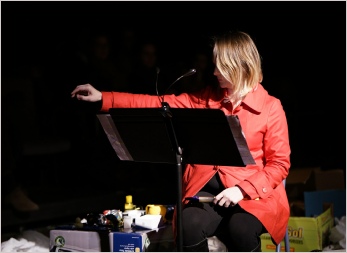
Nomi Epstein
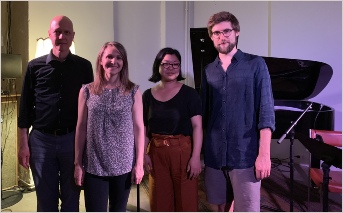
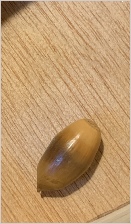
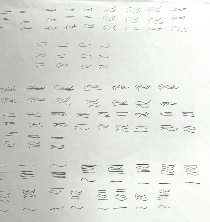
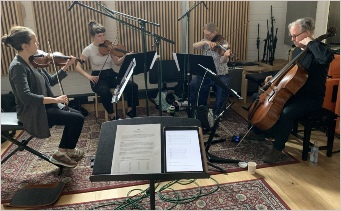
Recording with Apartment House, July 2023
Line drawings & the acorn from ‘Sextet’ residency
Rehearsing ‘sounds for Berlin’, June 2019 20192023